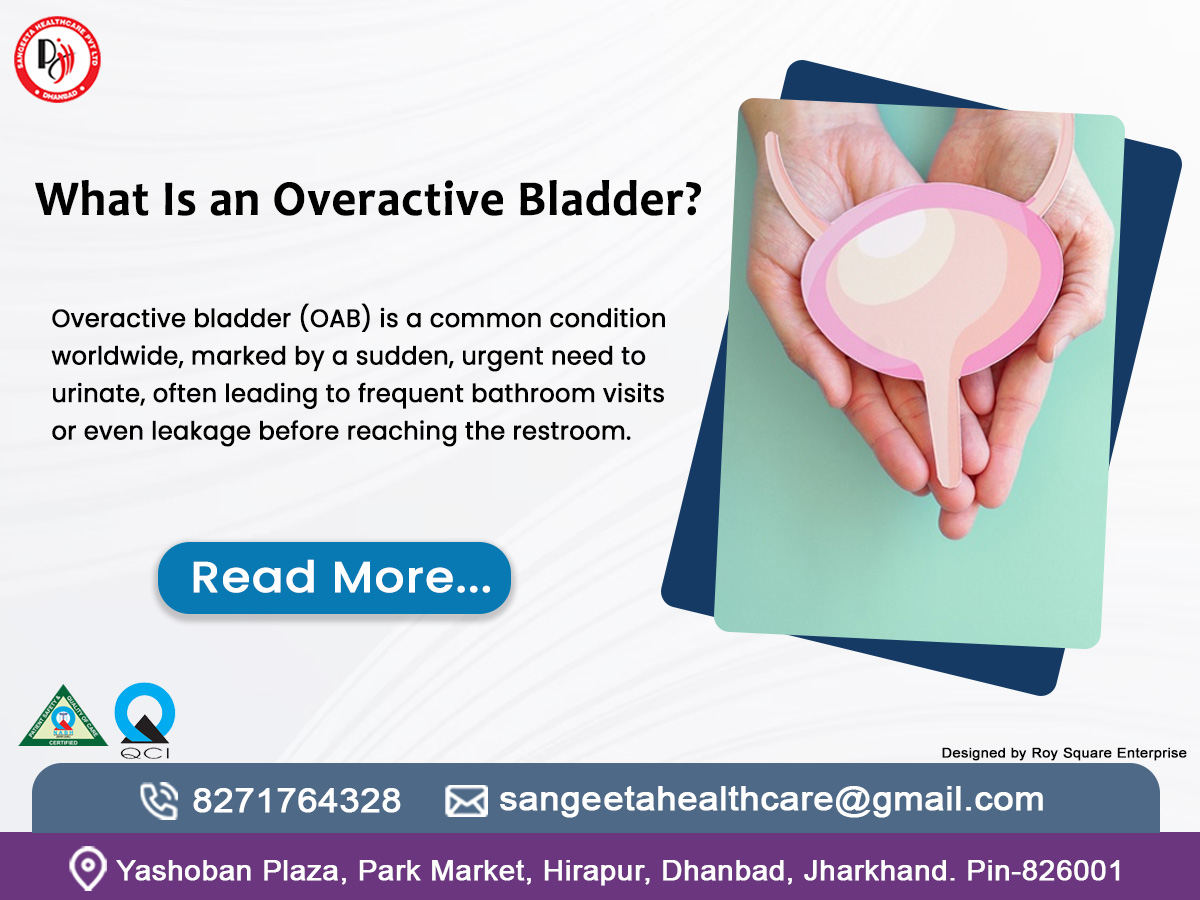Overactive bladder (OAB) is a common condition worldwide, marked by a sudden, urgent need to urinate, often leading to frequent bathroom visits or even leakage before reaching the restroom. The bladder’s detrusor muscle suddenly tightens, mistakenly telling the brain the bladder is full. Though millions experience OAB, many stay quiet due to embarrassment. Unlike stress incontinence, linked to physical activity, OAB is defined by urgency and frequency.
More than a minor hassle, OAB can disrupt daily life, turning simple tasks into challenges. For healthcare professionals, it’s a unique urological issue requiring tailored care. For the public, it’s a chance to break the stigma and support those affected. With the right approach, Overactive Bladder can be managed, helping people regain control and confidence.
Symptoms of Overactive Bladder
Recognizing the symptoms of overactive bladder is the first step toward seeking help. While symptoms can vary in severity, they typically include:
- Urgency: A sudden, intense need to urinate that’s difficult to delay. This is the hallmark of OAB and often the most distressing symptom.
- Frequency: Needing to urinate more than eight times in a 24-hour period, even if the volume of urine is small.
- Nocturia: Waking up two or more times at night to use the bathroom, disrupting sleep and leaving you fatigued.
- Urge Incontinence: In some cases, the urgent need to urinate leads to involuntary leakage before reaching the toilet.
These symptoms can range from mild to debilitating. For example, a medical professional might note that urgency is tied to detrusor overactivity, while a layperson might simply feel overwhelmed by the constant interruptions. Either way, OAB isn’t just “a weak bladder”—it’s a condition with specific physiological roots that deserve attention.
Causes of Overactive Bladder
So, what causes overactive bladder? The answer isn’t always straightforward, as OAB can arise from a variety of factors. Understanding these triggers is key to both diagnosis and treatment. Here are the primary causes:

- Neurological Disorders: Conditions like Parkinson’s disease, multiple sclerosis, or stroke can disrupt the nerve signals between the brain and bladder, leading to involuntary contractions.
- Bladder Abnormalities: Tumors, stones, or inflammation (e.g., from urinary tract infections) can irritate the bladder lining and provoke OAB symptoms.
- Aging: As we age, bladder elasticity decreases, and pelvic floor muscles weaken, making OAB more common in older adults.
- Medications and Lifestyle: Diuretics, caffeine, and alcohol can exacerbate bladder irritability, while obesity may put extra pressure on the pelvic region.
- Idiopathic Causes: In many cases, no clear cause is identified—termed idiopathic OAB. This doesn’t mean it’s untreatable, just that the trigger remains elusive.
For healthcare providers, pinpointing the cause often involves a detailed patient history and diagnostic tests. For the general public, it’s helpful to know that OAB isn’t always your fault—sometimes it’s a mix of genetics, environment, and physiology.
Overactive Bladder Diagnosis: How It’s Identified
Diagnosing OAB requires more than just noting symptoms—it’s about ruling out other conditions and confirming the root issue. A urologist or primary care provider might use:
– Urinalysis: To look for signs of infection or blood in the urine
– Bladder Diary: Patients track their fluid intake, urination frequency, and leakage episodes over a few days.
– Urodynamic Testing: This measures bladder pressure and function, often reserved for complex cases.
– Cystoscopy: A small camera examines the bladder for structural issues.
For the layperson, keeping a bladder diary can be an empowering first step before seeing a doctor. For medicos, these tools provide a roadmap to distinguish OAB from conditions like interstitial cystitis or prostate enlargement.
Treatment of Overactive Bladder
The good news? Overactive bladder is highly treatable, with options ranging from lifestyle tweaks to advanced medical interventions. Here’s an outline of the best methods:

-
Lifestyle Modifications
Simple changes can make a big difference:
– Bladder Training: Slowly extending the time between bathroom trips to help your bladder get used to a new schedule.
– Diet Adjustments: Cutting back on bladder irritants like caffeine, spicy foods, and artificial sweeteners.
– Pelvic Floor Exercises: Kegel exercises strengthen the muscles that control urination, reducing urgency and leakage.
-
Medications
For cases needing more support, medications are a game-changer:
– Anticholinergics (e.g., oxybutynin, tolterodine): These relax the detrusor muscle, reducing spasms.
– Beta-3 Agonists(e.g., mirabegron): These increase bladder capacity and ease urgency.
Side effects like dry mouth or constipation are possible, so doctors tailor prescriptions to the patient.
-
Advanced Therapies
When basics aren’t enough, cutting-edge options step in:
– Botox Injections: Injected into the bladder wall, Botox calms overactive muscles for up to six months.
– Neuromodulation: Devices like sacral nerve stimulators regulate nerve signals to the bladder.
– Surgery: Rarely, procedures like bladder augmentation are used for severe, refractory cases.
-
Overactive Bladder Remedies at Home
For those seeking natural relief:
– Herbal Supplements: Pumpkin seed extract and magnesium have shown promise in small studies.
– Hydration Balance: Drinking enough water (but not too much) prevents irritation without overloading the bladder.
Living with Overactive Bladder: Practical Tips
Beyond treatment, managing Overactive Bladder is about reclaiming control. Wear absorbent pads for confidence during outings, plan bathroom breaks ahead of time, and don’t shy away from discussing symptoms with a doctor. For medical professionals, counseling patients on these strategies can improve compliance and outcomes.
Take Control of Your Overactive Bladder Today
✅ Limit Irritants– Cut back on caffeine (coffee, tea, soda), alcohol, and spicy foods.
✅ Stay Hydrated, But Not Too Much – Drink enough water, but avoid excessive fluids before bedtime.
✅ Train Your Bladder – Gradually increase time between bathroom trips to improve control.
✅ Do Pelvic Floor Exercises (Kegels) – Strengthen bladder muscles by squeezing (like stopping urine flow) regularly.
✅ Maintain a Healthy Weight – Extra weight puts pressure on your bladder.
✅ Quit Smoking – Smoking can worsen bladder irritation and coughing can cause leaks.
✅ Avoid Constipation – Eat fibre-rich foods to prevent straining, which weakens pelvic muscles.
FAQs About Overactive Bladder
- Is OAB the same as urinary incontinence?
No, though they can overlap. OAB is about urgency and frequency; incontinence is the leakage itself.
- Can stress cause OAB?
Stress doesn’t directly cause it but can worsen symptoms by heightened nerve sensitivity.
- How common is OAB?
It affects about 15-20% of adults over 40, though many don’t seek help.
- Can OAB Go Away on Its Own?
Sometimes—if caused by temporary issues (like a UTI or too much coffee). But chronic OAB (from aging, nerve problems, etc.) usually needs treatment. Lifestyle changes and exercises can help manage symptoms.
- Should I Drink Less Water for OAB?
No! Dehydration makes urine more irritating. Instead:
✔ Drink 6-8 cups of water daily (spread out).
✔ Avoid bladder irritants (coffee, soda, alcohol).
- Are Women More Likely to Get OAB?
Yes—due to pregnancy, childbirth, and menopause. But men can get it too, especially with prostate issues after 50. Treatments work for both!
- Does Stress Worsen OAB?
Yes! Anxiety can make urgency worse. Try:
✔ Deep breathing
✔ Mindfulness
✔ Regular exercise (like walking)
- Is OAB a Sign of Something Serious?
Usually not, but tell your doctor if you have:
❌ Blood in urine
❌ Pain while peeing
❌ Sudden weight loss
- Can Exercise Affect OAB?
Good: Kegels, yoga, walking (strengthen pelvic muscles).
Avoid: Jumping/running if they cause leaks.
- How Long Until OAB Treatments Work?
– Lifestyle changes: 6-12 weeks
– Medications: 2-4 weeks
– Botox injections: Works fast but needs repeats



